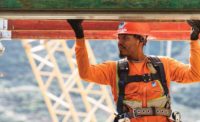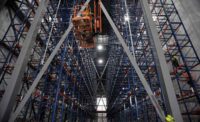"We expect some cutbacks in capital expenditures from our refining customer base as a natural market response to the crude-oil price decline," says Keith Manning, executive vice president of Zachry Group. However, he says midstream and downstream opportunities continue to be healthy. "Methane and ethane-driven projects in the petrochemical sector remain quite strong, as is LNG, and the power generation sector is moderate."
"Both on the power generation and the process and industrial side, customers are remaining conservative," says Michael P. McMahon, president of Day & Zimmermann. "While we've yet to see significant spend on new capital projects, we're hoping that the continued recovery of the economy, combined with lower oil prices, may drive more investment in projects."
The drop in oil prices has boosted some markets. For example, the airline industry has benefitted from lower fuel prices. "That savings goes right to the bottom line of the airlines," says Richard Cavallaro, CEO of Skanska USA. He says some of the savings now are going into plans for airline-terminal expansions.
Manufacturing is another market that has gained from the recent lower oil prices. "Cheaper energy prices are luring a lot of manufacturers from overseas to build here in the U.S., particularly in the Midwest," according to Mike Bolen, CEO of McCarthy Holdings. He notes that foreign manufacturers are particularly interested in building production facilities here for products with local distribution.
Some contractors worry that the strengthening of the U.S. dollar against other currencies may blunt this foreign capital investment in the U.S. In the past 10 months, the euro has gone from $1.38 to as low as $1.07, and the Japanese yen has gone to 120 yen to the dollar from 96, raising the costs of foreign investment.
However, McQuade of AECOM says he has not seen a drop-off in foreign direct investment in the U.S. "There still is a lot of interest in Asia and the Middle East in investing in projects in the U.S. When there is a lot of turmoil in the world, overseas investors look to the U.S. as a safe haven," he says.
The power market should be a beneficiary of lower oil and gas prices. There now are signs of interest in converting plants to gas from other fuels. "Natural gas continues to be the driver for most new large-scale generation projects. The growing accessibility of domestic supply, relatively low prices and reduced carbon footprint are contributing to the increased number of projects being developed," says William F. Griffin Jr., CEO, Gemma Power Systems.
However, many contractors don't see a sudden rush to convert existing plants to gas or build greenfield plants. "I don't think we'll see any drastic changes in the near term in the power-generation industry," says McMahon. But he agrees that most of the work continues to be focused on new natural-gas construction or coal-to-natural-gas conversions.
Public-Private Patience
The promise of new work through the use of public-private partnerships in the U.S. has yet to be fulfilled. "The P3 market has yet to mature here the way it has in Europe and Canada," says McQuade of AECOM. He believes the market will grow as more federal and state regulations authorize P3 and they become more familiar to public agencies.
Turner Construction is planning to be ready when P3 projects become more commonplace in the U.S. "A few years ago, we had very little work in Canada. Now, we have about $800 million, and that is a big P3 market. [That work] will help us prepare when P3 projects start to break here is the U.S.," says Di Filippo. "We believe that, if you wait until a trend like P3 starts making headway, you are already behind the game."
Putting together P3 packages can be arduous. "We see a reliable pipeline of P3 projects coming over the next four to five years," says Cavallaro. He notes that Skanska has an advantage because it has a sister company that helps with financing P3 projects. Developing a P3 proposal is a long and expensive process, Cavallaro cautions, adding, "You have to choose carefully which P3 group and project to join. You can't lose too many of these bids because it will cost you."





Post a comment to this article
Report Abusive Comment